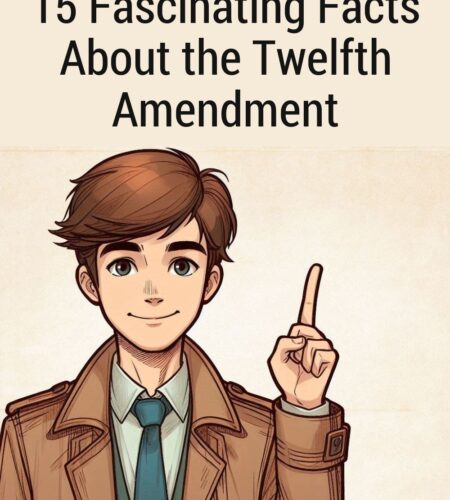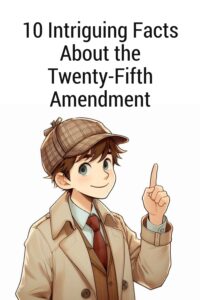The Twelfth Amendment to the United States Constitution is a significant piece of legislation that outlines the electoral process for the President and Vice President of the United States. While not as well-known as some other constitutional amendments, it plays a crucial role in the American political system. In this article, we will explore 15 intriguing facts about the Twelfth Amendment.
Introduction
The Twelfth Amendment was ratified in 1804 and modified the way the Electoral College functions. It was introduced after the controversial presidential election of 1800 and sought to address the issues that arose during that election. Let’s delve into the details of this important amendment.
Fact 1: The 1800 Election Chaos
The Problem of the Original System: Prior to the Twelfth Amendment, presidential elections did not distinguish between electoral votes for President and Vice President. The candidate with the most electoral votes became President, and the runner-up became Vice President. This led to issues like the 1800 election.
The Election of 1800: The election of 1800 was a contentious and confusing affair, with candidates from opposing parties, Thomas Jefferson and Aaron Burr, receiving the same number of electoral votes. The tie had to be decided by the House of Representatives, and Jefferson eventually emerged as President.
Calls for Reform: The chaos of the 1800 election highlighted the need for a constitutional amendment to prevent such situations in the future.
Fact 2: The Twelfth Amendment’s Proposal
Introduced by Congress: The Twelfth Amendment was proposed by Congress on December 9, 1803, during Thomas Jefferson’s presidency.
Ratification: It was ratified by the states on June 15, 1804, and subsequently became part of the Constitution.
A Constitutional Solution: The Twelfth Amendment offered a clear and constitutional solution to the problems arising from the original electoral system.
Fact 3: Separate Electoral Votes
Separate Ballots for President and Vice President: The Twelfth Amendment introduced the concept of separate ballots for President and Vice President in the Electoral College. Electors would cast one vote for President and another for Vice President.
Eliminating Ties: This change aimed to eliminate the possibility of ties like the one that occurred in the 1800 election.
Fact 4: The Role of the House of Representatives
Contingent Election by the House: If no candidate receives a majority of electoral votes for President, the Twelfth Amendment outlines that the House of Representatives will choose the President from among the top three candidates. Each state delegation in the House has one vote.
Preventing Deadlocks: This provision ensures that in the event of a tie or lack of a clear majority, a President can still be selected without the complications of the 1800 election.
Fact 5: The Role of the Senate
Contingent Election by the Senate: If no candidate receives a majority of electoral votes for Vice President, the Senate will choose the Vice President from among the top two candidates.
The Senate’s Role in a Split Ticket: This provision allows for the Senate to resolve any ties or lack of a clear majority in the Vice Presidential election.
Fact 6: The 1804 Presidential Election
First Election Under the Twelfth Amendment: The 1804 presidential election was the first to be held under the Twelfth Amendment’s new rules. It was the election where Thomas Jefferson was re-elected for his second term.
Smoothing the Electoral Process: The Twelfth Amendment successfully smoothed the electoral process and eliminated the potential for ties in both the presidential and vice-presidential elections.
Fact 7: Faithless Electors
Electoral College Behavior: The Twelfth Amendment did not address the issue of “faithless electors,” those who do not vote in line with the popular vote in their state.
Laws Vary by State: Laws regarding faithless electors vary by state, with some states imposing penalties on electors who do not follow their state’s popular vote.
Supreme Court Ruling: In 2020, the U.S. Supreme Court ruled that states can require electors to vote for the candidate chosen by the state’s voters.
Fact 8: The Twelfth Amendment and the Two-Party System
Consolidation of Parties: The Twelfth Amendment contributed to the consolidation of the American political system into a two-party system. With separate ballots for President and Vice President, it became more difficult for candidates from different parties to form an executive branch together.
Partisan Elections: The amendment paved the way for partisan elections, where running mates from the same political party become President and Vice President.
Fact 9: The Election of 1824
Another Contested Election: The election of 1824, often referred to as the “Corrupt Bargain” election, was another contested presidential election. Four candidates split the electoral votes, and John Quincy Adams was eventually chosen as President by the House of Representatives.
Controversial Results: The election of 1824 highlighted the continued complexities of presidential elections, despite the Twelfth Amendment’s reforms.
Emergence of New Parties: The election of 1824 contributed to the emergence of new political parties, such as the Democratic Party.
Fact 10: The Popular Vote and the Twelfth Amendment
The Twelfth Amendment and Popular Vote: The Twelfth Amendment does not mention the popular vote for President and Vice President. It primarily focuses on the functioning of the Electoral College.
State Laws Determine Popular Vote: State laws and regulations determine how the popular vote is conducted and how electoral votes are allocated.
National Popular Vote Movement: Some states have joined the National Popular Vote Interstate Compact, an agreement to allocate their electoral votes to the candidate who wins the national popular vote, regardless of the popular vote within their state.
Fact 11: The Amendment’s Clarity
Simplifying the Process: The Twelfth Amendment brought clarity and order to the presidential election process, making it easier for the American people to understand.
Reducing Uncertainty: It reduced uncertainty and ambiguity in the determination of the President and Vice President.
Long-Term Impact: The Twelfth Amendment’s principles have endured for over two centuries and continue to shape presidential elections in the United States.
Fact 12: The Impact of Third-Party Candidates
Influence on Third Parties: The Twelfth Amendment indirectly influenced the influence of third-party candidates. Due to the difficulties presented by the Electoral College system, third-party candidates face significant barriers in achieving electoral success.
Third Parties and the Spoiler Effect: In some cases, third-party candidates are accused of acting as spoilers, potentially altering the outcome of a presidential election.
Challenges to Third-Party Success: The Twelfth Amendment’s structure makes it challenging for third-party candidates to garner the necessary electoral votes to become President.
Fact 13: The Modern Era and the Twelfth Amendment
Adaptation to a Changing Nation: The Twelfth Amendment has adapted to the changing needs of the United States, as the nation has grown and evolved.
Challenges and Innovations: As technology and society have changed, challenges such as cybersecurity and the role of social media in elections have emerged, necessitating ongoing adaptation in election processes.
The Role of Political Parties: The Twelfth Amendment’s impact is closely tied to the role of political parties in the modern electoral process.
Fact 14: The Need for Clarity
Ongoing Importance: The Twelfth Amendment remains essential for providing clarity in presidential elections.
Preventing Disputed Outcomes: Its provisions are designed to prevent disputed outcomes like those seen in the early days of the United States.
Constitutional Adaptation: The Constitution’s capacity to adapt to the needs of the nation is evident in amendments like the Twelfth Amendment.
Fact 15: Proposals for Electoral Reform
Proposals for Reform: Over the years, there have been various proposals for reforming the electoral process, including replacing the Electoral College with a national popular vote.
National Popular Vote Compact: The National Popular Vote Interstate Compact, mentioned earlier, is one example of a proposed reform that aims to ensure the candidate who wins the national popular vote becomes President.
Ongoing Debate: The debate over electoral reform continues to be a significant topic in American politics.
Conclusion
The Twelfth Amendment to the United States Constitution is an important piece of legislation that has played a crucial role in shaping the American electoral system. It was introduced to address the issues arising from the original electoral system, notably the chaotic 1800 election. By introducing separate ballots for President and Vice President in the Electoral College, the Twelfth Amendment sought to eliminate ties and bring clarity to the presidential election process. While it has provided a level of stability, it has not been without controversy, and the ongoing debate over electoral reform remains a significant topic in American politics.
Subscribe to our email newsletter to get the latest posts delivered right to your email.






Comments